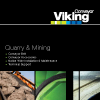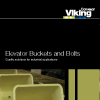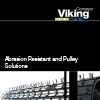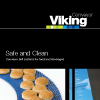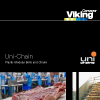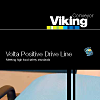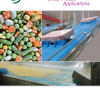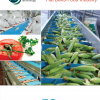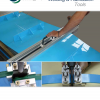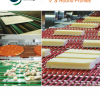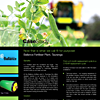What is the new AB modular product for the corrugated board industry?
uni JCB is the product name for the next generation modular belt designed especially for product handling within the corrugated board Industry. We plan that the new JCB modular belt will eventually replace the existing QNB belt and become our new standard solution for corrugated board handling.

Why change to a new product when the existing uni ANB belt holds the market leading position?
We now have many years of experience operating our modular belts within all types of corrugated production plants; we have gained a reputation for total reliability and excellent service but as a responsible business partner to the corrugated producers we concluded we could still offer more. The modern corrugated plant operates in a very competitive market segment where production speed and efficiency are critical for a plants survival.
We looked at many aspects of what was needed to further improve the role of our modular belts within the corrugated manufacture process, this work lead us to the conclusion that an improved solution was possible and was needed, hence our next generation product, the JCB modular belt was born.
JCB is the product name for the next generation modular belt designed especially for product handling within the corrugated board Industry. We plan that the new JCB modular belt will eventually replace the existing QNB belt and become our new standard solution for corrugated board handling.
The surface of the new JCB belt is very different to all existing modular belts used in corrugated handling, is the necessary?
Yes, very necessary. One of our main focus areas were our observation of corrugated plant personal working on moving modular conveyor belts. We noted plant operators often standing partly on our belts and partly on the surrounding floor. The conveyor systems automatically index the stack of corrugated products forwards in some cases with personal still standing on the belts.
Our existing QNB belts offer a much better working environment than the previous conveyor systems used such as powered roller conveyors and slat / roller combinations. Standing on the surface of the QNB belts resulted in a much safer working environment than roller conveyors, but we concluded further improvement are also possible and these were incorporated into the new JCB belt surface design.
Anything which can help to increase worker safety should always be a high priority and with increasing liability place on plant owners and managers, the corrugated industry appreciates highly this new extra contribution we make towards worker safety.

Why does the JCB belt surface feature a Y profile?
With the JCB belt we invented the Y surface profile; this surface combines the needs of several functions. The main objective was to improve the non-slip properties of the belt surface whilst at the same time offering a support surface which would not damage or mark the corrugated boards. Thus the Y surface is a careful balance between improving non-slip conditions and non-marking support of corrugated lower sheets.
A tapered or sloping edge profile is retained at both sides of each modular links top surface to ensure no snag points exist when corrugated stacks are pushed sideways on transfer units or stacks have their direction rotated on special conveyor sections. In addition the Y surface plays an important role in improving the mechanical properties of the belts, the extra material in the Y top profile has been placed inline with the tensile force lines between hinges and serves to increase the overall belt tensile stiffness.
Why add the bright coloured links used at both belt edges, and why change from yellow strips across the belt width?
We noted the edges of worker platforms mounted flush with the belt surface and the top side of the moving belt needed to be much more obvious. yellow links added as strips at intervals along the belt length help to indicate when a belt was moving but did little to bring to operators attention the edge zone of the belting.
Safetyof gangways and work-zones thus we elected to have these bright coloured links as a standard feature of JCB belting.
A worker based on the corrugator down-stacker takeaway zone regularly walks onto the take away belts from the side area thus clear bright marking of the belt edge position is a critical part of being continually safety focused.

Standard construction of all JCB belts for the corrugated industry will incorporateorange links 76mm wide (3 inches) mounted on alternating pitches along both belt edges. We place the safety markings in line with the risk area.
Photo above. Existing system, marking of belt edges will improve operator safety.
Why standardise on the Y surface JCB at all locations in the corrugated plant?
Our modular belts have transformed the operation of modern high volume corrugated plants. Stacks of corrugated products are automatically transferred from the main corrugator machine automatically to downstream operations.
The materials handling conveyors now fill most of the free space between machinery in the production halls, thus personal need to cross these conveyors to reach their workplace or at some locations actually need to walk on the belts surface as part of their normal work pattern.
Movement around the corrugated plant without crossing the conveyors is almost impossible due to the many routes filled by conveyor systems. Conveyors seem to be crossed often at both official and unofficial locations, workers walk between stacks on moving conveyors, thus we concluded the Y surface offered advantages at all locations and should be adopted as a common standard throughout the production line to improve safety.
Will the JCB belt interchange with existing QNB belts?
JCB belts will fit existing conveyor frames and run on the existing standard QNB sprockets. JCB belting is manufactured to the same overall belt widths as the existing QNB belts. This means OEM conveyor builders avoid costly re-design of their conveyor frames, their existing construction standards can be re-used with the new JCB belts.
Recommended sprocket spacing for JCB belts is at a pitch of 76mm (3 inches) across the drive shaft, exactly the same as we recommend for the existing QNB belts, so again no design changes or alterations are needed to accommodate the new belt. In most cases it is simply a matter of removing an existing ANB modular belt and pulling on the new JCB belt, a task that is possible within a few minutes, the need for a planned shutdown to change belt types is thus avoided.
Will the Y surface damage or mark the corrugated products?
The Y surface profile was subjected to extensive testing; we placed various qualities of corrugated board from heavy duty industrial grades to the micro flute types in contact with the Y surface profile under pressures equivalent to highest stack piles used at elevated temperatures and humidity to simulate conditions when hot stacks first leave the corrugator. no marking or surface damage to the corrugated boards was detected during the testing.
Already we have JCB belts running on several applications; direct contact pressure between stack and belt is not resulting in any marking of the lower sheets.
We only received compliments about the new bright, clean hygiene appearance of the JCB belt surface.
Can JCB belts be used for handling pallets?
Yes. In addition to running in direct contact with corrugated sheets JCB have been installed on end of line conveyors handling stacks on pallets. When handling pallets the belts are subject to high point loadings, to ensure maximum performance is obtained the belt must be fully supported on a deck totally converted with wear-strip material.
The quality of the wearstrip materials used can have a large influence on the performance of the system; with correct specification materials lifetimes of several years can be obtained.
Why have you added a curved surface to the underside of the belt?
Our customers asked for this feature, we are not the first to do this. The curved surface reduces the cordial lifting effect when the belt passes around the transfer roller mounted at each end of the belt carry way. The means smoother transfer between conveyors and less contact pressure points. This is an advantage when handling large heavy stacks and also when handling not so stable, smaller footprint stacks.

What is the load rating of the new JCB belt?
We rate the JCB belt with the same working load capacity as the existing QNB belting at 35, 000N/m. this is still the highest load rating of all the similar modular belts used in the corrugated industry.
However with the new JCB design we have been able to increase belt tensile stiffness significantly according to the request of some of our OEM customers. Belt tensile stiffness is important with the type of conveyors used in the corrugated industry, since they are built to a very low profile height meaning little space exists under the conveyor frames to accommodate elastic expansion of the belt length when the drive takes up the loading. Rubbing contact between the floor and the belt should be avoided so the additional belt stiffness is a clear advantage with these limited height conveyors.
How did you manage to increase the belt tensile stiffness?
We took advantage of a combination of the new Y surface ribs and the belt top closed area, and made this material in the top part of the belt efficiently transmit more tension by moving the hinge pins closer to the top surface. In addition the new belt features double the number of hinges across each link module thus reducing the influence of pin deflection.
Overall the belt material is used in a much smarter and efficient way to be benefit to increased belt performance. Moving the pins closer to the top surface has the added advantage of leaving more material for wear life below the pin holes
How easy is the JCB belt to handle and assemble?
One of the major features of our existing QNB is the lock-pin system; the enables quick and simple mounting and dismounting without need for removing locks or chips, no special tooling is needed just simple hand tools.
Lock-pins simply snap in and out as required but are able to resist the high sideways forces that exist when heavy stacks are placed off centre on these belts.
How do we ensure the JCB belt surface remains clean and un-marked?
JCB belts will provide a clean safe and hygienic surface giving the best results for the corrugated producers. Conveyor design plays an important role in maintaining a clean bright top belt surface, combined with the correct conveyor seign our modular belts will remain clean and mark free. Metal oxides from low quality or non- revolving conveyor rollers used to support the belts return path can mark the top surface of the belting, so take care to avoid these conditions.
Do you have JCB belts running in the corrugated industry?
Following extensive trails on several development conveyors, JCB belts are already working hard running on applications at SCA Packaging on a full new line and Smurfit Kappa corrugated plants in selected applications.
What should i do when i find a new conveyor project in my sales area?
For commercial support and guidance, please contact Viking Conveyor on 0800 845 646. For JCB belt technical support please contact your local product manager.





